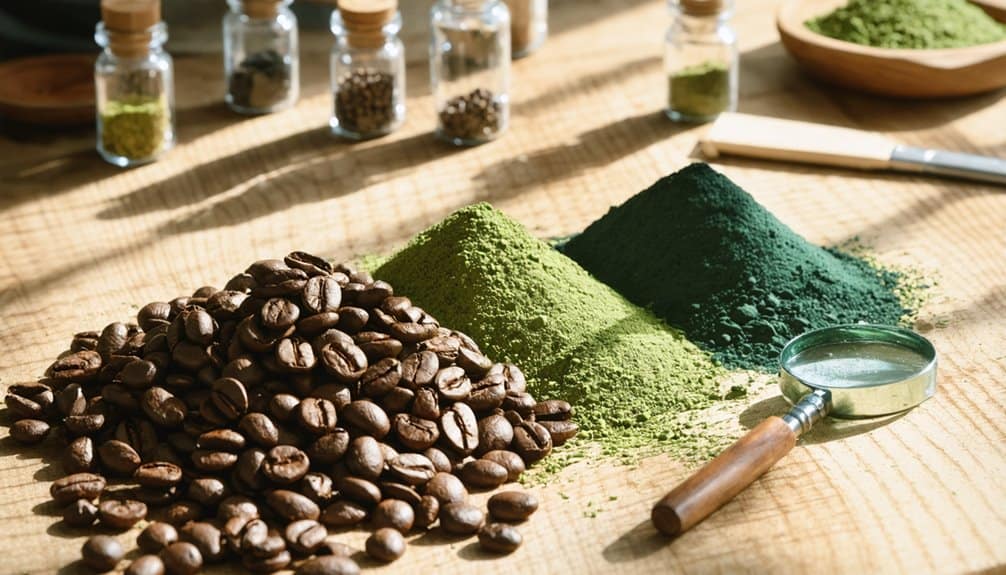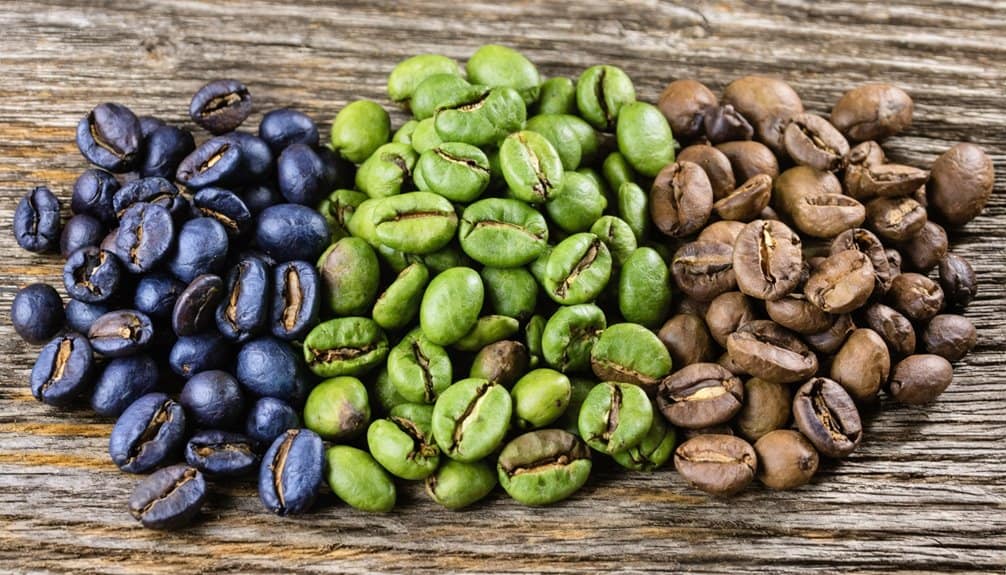When you roast single-origin beans at home, you’ll reveal distinct flavor profiles shaped by specific growing conditions and terroir.
Premium altitude-grown varieties offer brighter acidity and complex tasting notes that shine through light roasting temperatures of 350-400°F.
You’ll gain precise control over the roasting process to highlight unique characteristics like fruity, floral, and citrus flavors – especially evident in washed or honey-processed beans.
With transparent sourcing and quality control measures, you can verify authenticity while experimenting with custom roast profiles.
The expedition from farm to cup reveals deeper layers of specialty coffee appreciation.
Key Takeaways
- Single-origin beans deliver unique flavor profiles influenced by specific growing regions, allowing home roasters to highlight distinct characteristics.
- Home roasting gives precise control over roast levels to enhance natural flavors, sugars, and acids in high-quality beans.
- Green single-origin beans store longer than pre-roasted coffee, enabling bulk purchases while maintaining freshness.
- Traceability ensures authenticity and quality, letting home roasters select beans from specific farms or regions.
- High-altitude single-origin beans provide complex flavor notes that can be optimized through custom roast profiles.
Understanding Single-Origin Coffee Benefits

Single-origin coffee beans deliver four distinct advantages that make them superior for home roasting enthusiasts.
You’ll experience unique flavor profiles shaped by specific terroir conditions, with high-altitude beans offering brighter acidity and complex tasting notes.
Paradise Mountain’s beans, grown at 3700 feet elevation, exemplify the optimal growing conditions for premium coffee.
The beans’ natural composition includes vital minerals from nutrient-dense soil, supporting your health through organic cultivation practices that improve disease resistance.
You’re also supporting sustainable farming when you choose single-origin beans, as these small-batch harvests maintain local biodiversity and guarantee fair compensation for farmers.
Most significantly, you’ll benefit from complete transparency in the sourcing process.
Since these beans come from a single location, you can trace every step of production, assuring consistent quality and purity in your roasting process without the risk of chemical cross-contamination common in blended varieties.
Light Roasts Maximize Origin Flavors
Light roasting temperatures between 350-400°F improve the intricate flavor profiles inherent in specialty coffee beans.
You’ll find that lower temperatures preserve the bean’s natural sugars and acids, allowing you to experience the full expression of its terroir.
This gentle approach highlights fruity, floral, and citrusy notes that would otherwise be lost at higher temperatures.
Clarity in flavor is especially noticeable when using washed or honey-processed beans.
When you’re working with premium single-origin beans, especially varieties like Geisha or Kona, light roasting is your key to revealing their complex characteristics.
You’ll notice that African and South American beans particularly shine with this method, revealing bright berry notes and delicate floral undertones.
Keep in mind that light roasts need longer resting periods, typically 5-14 days, to fully develop their flavors and release trapped CO2, ensuring the best extraction during brewing.
Traceability and Quality Control

When sourcing premium beans for home roasting, traceability and quality control emerge as critical factors in achieving consistently excellent results.
You’ll find that transparent supply chains allow you to verify your beans’ authenticity and origin, ensuring you’re working with precisely the varietals you want for your roasts.
Quality control measures throughout the supply chain help preserve the distinct flavor profiles you’re seeking.
Modern platforms like TraceX enhance authenticity by providing detailed tracking from farm to cup.
You can track everything from farming practices to processing methods, which directly impact your final cup quality.
Real-time visibility into the supply chain helps you manage limited availability and seasonal variations, ensuring you won’t run short of your favorite beans.
Home Roasting Single-Origin Advantages
Building upon established traceability practices, home roasting single-origin beans offers distinct advantages that improve your coffee experience.
You’ll gain precise control over the roasting process, revealing the beans’ inherent flavor profiles while maintaining their unique regional characteristics.
When you roast at home, you’re joining a community of enthusiasts who understand that lighter roasts preserve delicate flavor notes and reduce acrylamide levels.
Ethical sourcing practices ensure fair compensation for coffee farmers who maintain exceptional quality standards.
- Control roast development to highlight origin-specific flavor notes, from bright Ethiopian florals to rich Colombian chocolates
- Store green beans longer without degradation, ensuring fresh roasts whenever you need them
- Experiment with roast profiles to optimize each bean’s unique characteristics
- Create custom roast levels that complement specific brewing methods while preserving origin integrity
Selecting Premium Origin Beans

The quest for premium single-origin beans demands a deep understanding of regional characteristics and quality markers.
When you’re selecting your beans, focus on altitude-grown varieties, as higher elevations develop complex sugar and acid profiles that’ll improve your roasting results.
You’ll want to examine the traceability information, ensuring you know the specific farm or region of origin.
Like the celebrated Supremos beans from Puerto Rico, your selection should deliver sweet chocolate notes in the cup.
Look for beans that showcase distinct flavor characteristics unique to their growing region.
You’ll find that farms practicing sustainable methods often produce superior beans with cleaner, more pronounced flavor profiles.
Pay attention to the processing method – whether natural or honey-processed – as this greatly impacts your final cup.
Consider farms using eco-friendly practices, as they’re more likely to maintain consistent quality while preserving the environment that makes their beans exceptional.
FAQs
How Long Can I Store Green Coffee Beans Before They Lose Quality?
You’ll maintain ideal bean quality for 6-12 months under perfect storage conditions (15-20°C, 50-60% humidity). While they’re technically viable for years, flavor compounds and processing characteristics deteriorate beyond 12 months.
What’s the Ideal Room Temperature and Humidity for Storing Single-Origin Beans?
Like a delicate dance of preservation, you’ll want to maintain your single-origin beans at 50-70°F (10-21°C) with 40-60% relative humidity. Store them in airtight containers away from heat sources.
Can I Blend Different Single-Origin Beans During Home Roasting?
You can blend single-origin beans, but you’ll want to roast them separately initially, as each origin requires unique roast profiles to highlight their distinct flavor characteristics and ideal development time.
Which Home Roasting Method Is Best for Preserving Single-Origin Characteristics?
Like a skilled conductor, you’ll get the best single-origin clarity from stovetop roasting, where precise heat control and active stirring let you orchestrate each bean’s unique flavor development perfectly.
How Do Seasonal Harvests Affect Single-Origin Bean Availability and Pricing?
You’ll find single-origin beans’ availability and prices fluctuating with harvest seasons, affecting their flavor profiles and market access. Peak harvests offer abundant supply with ideal flavor development, while off-seasons command premium prices.
The Bottom Line
When you’re roasting single-origin beans at home, you’ll reveal each region’s terroir – much like a winemaker revealing the essence of specific vineyard soils.
That Ethiopian Yirgacheffe’s wild blueberry notes or a Guatemalan Huehuetenango’s bright citrus acidity can only emerge through precise temperature control and initial crack timing.
By mastering origin-specific profiles, you’ll showcase the distinct characteristics that make each coffee singularly expressive of its homeland.
